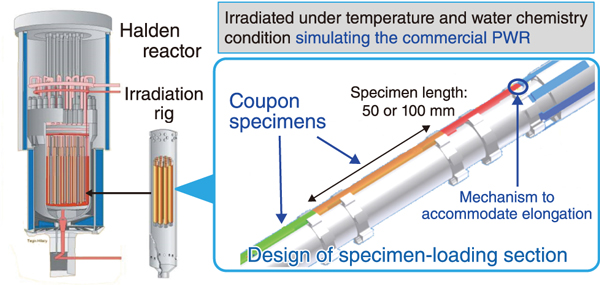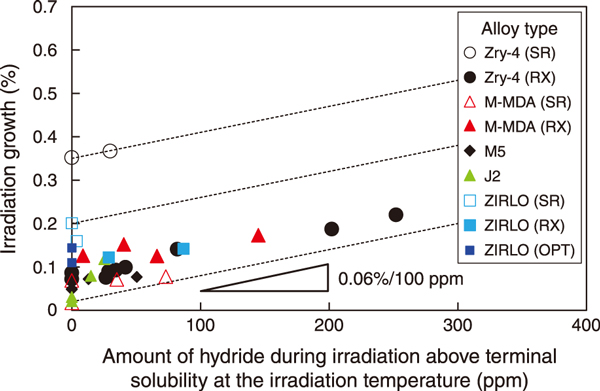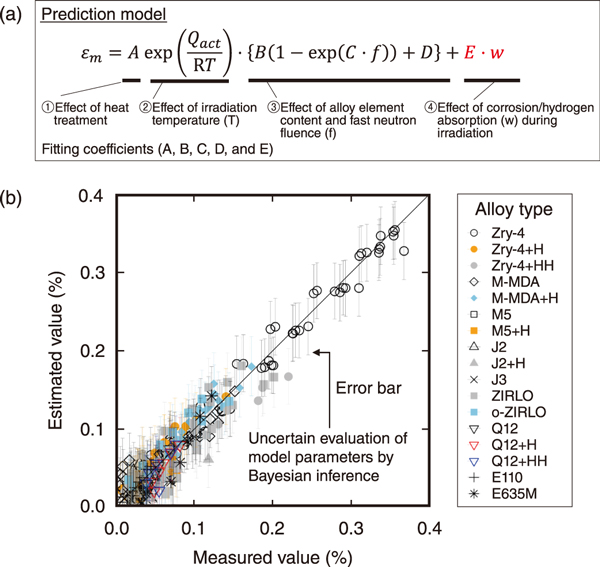
Fig.1 Outline of the irradiation growth test for the improved alloy cladding tube

Fig.2 Relation between the irradiation growth at the fast neutron fluence of 7.8 × 1025 (1/m2) and the amount of hydride exceeding terminal solubility at the irradiation temperature

Fig.3 Comparison of the estimated value using (a) the prediction model and (b) the measured value of the irradiation growth
A fuel rod loaded in the reactor core of nuclear power plants consists of fuel pellets and fuel cladding tubes made of zirconium alloy. From the viewpoint of improving safety and the effective utilization of nuclear power plants, the industry has been developing modified zirconium-based alloys that differ from conventional ones in order to enhance corrosion resistance.
Abnormal deformation was observed in certain fuel assemblies with the improved alloy cladding during irradiation tests conducted in USA in the 2000s. In general, irradiation-induced growth along the axial direction of the cladding tube due to neutron irradiation is recognized as one of the possible mechanisms of this kind of phenomenon. Hence, particularly, for the improved alloys, the accumulation of knowledge and a comprehensive understanding of irradiation-induced growth behavior, including the effects of alloy elements, fabrication conditions, and corrosion effects that develop during irradiation, are desirable.
We designed a systematic irradiation growth experiment for various types of improved alloy cladding tubes, which could potentially be introduced into domestic nuclear power plants in the near future. The irradiation test for various types of cladding tubes was conducted at the Halden test reactor in Norway for about 8 years with a specially designed test rig that simulated the typical irradiation conditions of Pressure Water Reactor (PWR) (Fig.1). The primary result of this project revealed the relationship between irradiation-induced growth and fast neutron fluence (∼7.8 × 1025 (1/m2)) through intermediate inspections to measure the dimensional changes of the specimens at specific intervals. Subsequently, post-irradiation examinations (PIEs) were conducted at the Reactor Fuel Examination Facility (RFEF) of JAEA. These examinations aimed to determine the weight gain and the amount of hydrogen absorbed into the metal due to waterside corrosion.
Through detailed analysis using the PIE data, it was clearly demonstrated for the first time that the addition of niobium (Nb) in the improved alloy led to the reduction of irradiation growth. In addition, it was revealed that the effect of hydride absorption, i.e., acceleration of irradiation growth, became significant when the hydrogen content exceeded the solubility limit at the corresponding irradiation temperature (Fig.2). Furthermore, taking advantage of the unique test design, namely, systematic test matrix and various types of cladding materials, the authors developed a comprehensive model for predicting irradiation growth, which depends on various conditions such as the elemental composition of the alloy (Fig.3). This model also supports the uncertainty assessment through Bayesian inference and is thus expected to work as an effective tool to audit evaluations by utilities from the perspective of nuclear regulations, as well as to facilitate more efficient development and improvement of fuel design by fuel vendors.
This study was performed under the contract research entrusted by the Secretariat of Nuclear Regulation Authority, Japan.
(Kazuo Kakiuchi)